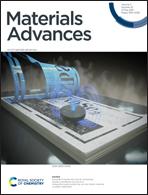Synthesis and superconductivity of new TiNiSi-type equiatomic germanide ThIrGe
Abstract
A new germanide ThIrGe has been synthesized and characterized by X-ray diffraction, transmission electron microscopy, electrical resistivity, magnetic susceptibility and thermodynamic measurements. The structural refinement shows that, in contrast to tetragonal ThIrSi, ThIrGe crystallizes in the TiNiSi-type orthorhombic structure with the Pnma space group (a = 7.2321(2) Å, b = 4.3802(1) Å, and c = 7.7107(2) Å), which is the first Th-based ternary equiatomic intermetallic compound of this structural type. Below Tc = 5.25 K, ThIrGe becomes a weak-coupling type-II superconductor with a fully isotropic superconducting gap. The Sommerfield coefficient, upper critical field, and Ginzburg–Laudau parameter are determined to be 11.8 mJ mol−1 K−2, 2.9 T, and 19.9, respectively. First-principles calculations indicate that the density of states at the Fermi level are dominated by a hybridized contribution from the orbitals of Th, Ir and Ge, and are enhanced by the spin–orbit coupling. In addition, we demonstrate that the structural difference between ThIrGe and ThIrSi can be understood in terms of the Gibbs formation energy.



 Please wait while we load your content...
Please wait while we load your content...